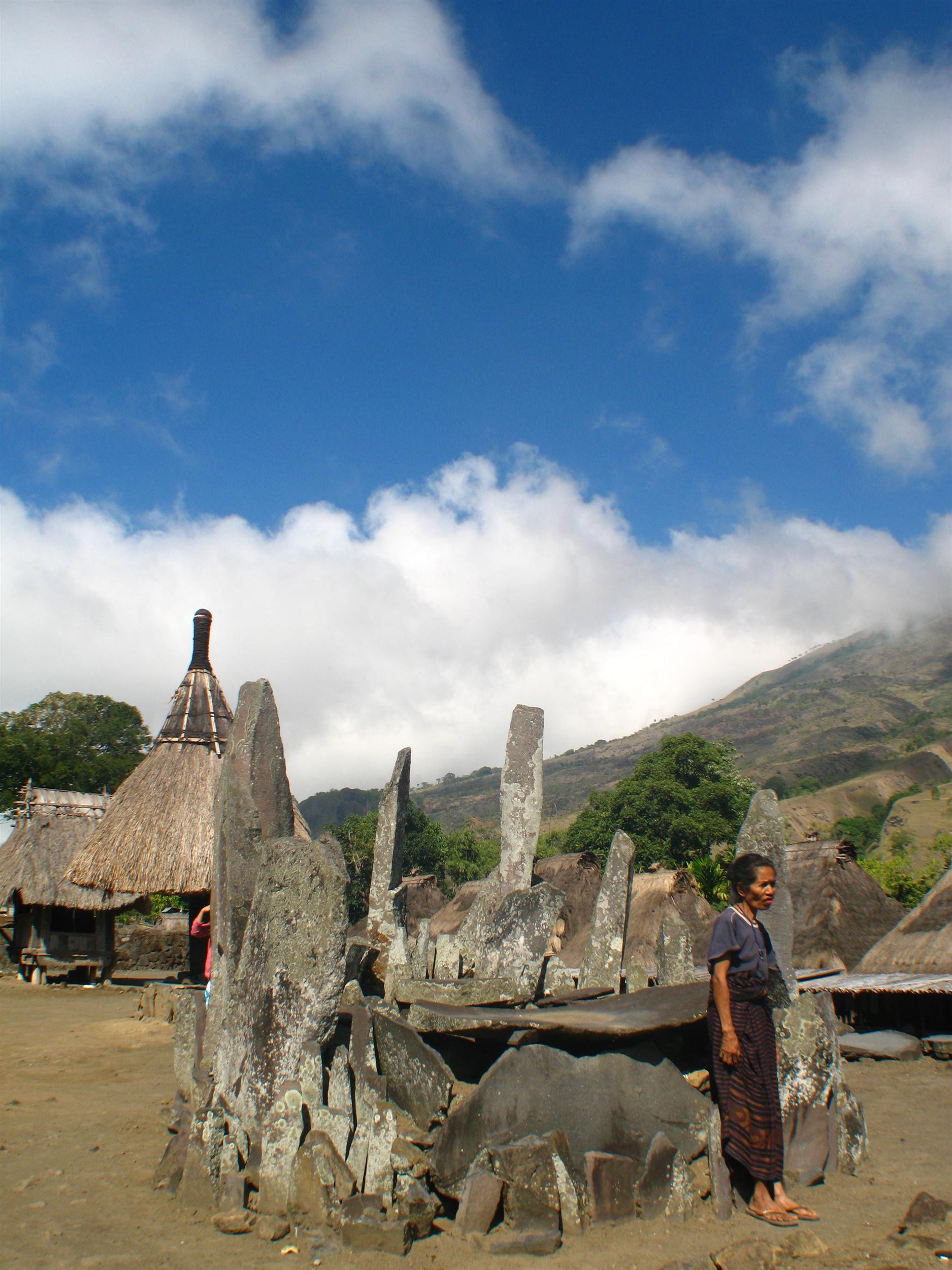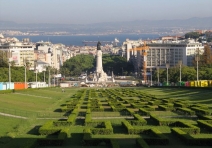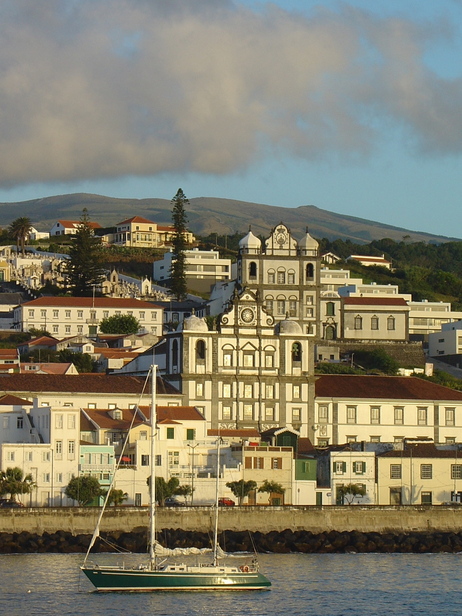A TRAVEL NEWS ARTICLE ABOUT THE AZORES, PORTUGAL
Nine small islands spread over nearly 400 miles far out in the Atlantic, over 800 miles from Portugal and some 2,330 miles from North America – the Azores. Adam Hart investigates.

A satellite view of The Azores
The volcanic islands of the Azores, on the geological time scale, are young islands. All but one of them date back to the Quaternary period, which means they could have been formed – give or take the odd 1,000 years – up to 2.5 million years ago, the exception, Santa Maria, apparently being from the earlier Miocene Era within the Tertiary Period. They were pushed up some 6000 metres from the depths of the ocean at the point where the Atlantic rift met the fault line that separates the African from the Eurasian continents. They weren’t pushed up very tidily either as they spread out over almost 400 miles in three groups. In the east of the archipelago are the islands of Santa Maria and Sao Miguel, then there are the five central islands of Faial, Terceira, Sao Jorge, Graciosa and Pico and to the west Flores and Corvo.
Why the islands are called Azores is unclear. One theory is that the early Portuguese explorers saw birds which reminded them of goshawks (açor), another that the word is derived from an old Portuguese word for blue.
As some of the youngest islands in the world, they seem to be behaving in a somewhat teenage manner having the occasional tantrum by letting off outbursts of seismic or volcanic activity. One such eruption in the early 19th century caused a tiny islet to appear, to the delight of an English sea captain who promptly named it after his ship, but the islet vanished beneath the waves just a few days later.
However, all that underground activity makes great interest for visitors who come to see the fumaroles, geysers or hot springs such as those at Furnas on Sao Miguel. The ground on the north shore of the Lagoa das Furnas is so hot the islanders go there to cook their meat and vegetable stews in it. The meal takes five hours to cook and the meat just melts in the mouth.
The uninhabited Azores were sighted in the 14th century but it wasn’t until 1427 that Santa Maria was actually discovered by a Portuguese expedition. Since 1976 the Azores have been an autonomous region of Portugal.
Whilst today the Azoreans income is chiefly from farming, in years gone by the Azores prospered from trade with America and also from whaling. In more recent years the islands have also been used as bases for transatlantic cable companies, meteorology and the military.
Tourism has reached these islands but with the lack of beaches, variable and often wet climate and the absence of large resorts they are more suited to the discerning traveller who wants to explore their beauty, the mountains and enjoy their uniqueness and tranquillity away from the crowds.
Santa Maria – a charming island, arguably with the best climate and beaches, studded with white houses with curious, tall chimneys. During the Second World War the Americans built an airport on its dry grassy plateau, which today is used for international civil air traffic. Visit Anjos where Christopher Columbus visited, Santo Espirito to see its black and white lava-decorated church and S. Lourenco Bay, one of the Azores’ most beautiful bays with its vine-covered cliff.
Sao Miguel – the largest island. Ponta Delgada, its main town, is also the capital of the Azores, with impressive churches, buildings and charming cobbled streets denoting its earlier prosperity. You could easily spend a week exploring this beautiful island. Visit Sete Cidades – a seven-mile caldera; the steaming, bubbling Achada das Furnas; the crater lake of Lagoa do Fogo; and close by Ribeira Grande with its fine old mansions and the dramatic cliffs on the east coast of the island.

Sao Miguel scenery
Terceira – the third largest island is noted for its architecture, festivals, verdelho wine and bull-running. The town of Angra do Heroismo, in its idyllic setting, was declared a UNESCO World Heritage Site in 1983 in recognition of the role its port has played in the Atlantic. Visit the colourful sulphur wells of Furnas do Enxofre and the Algar do Carvao with its subterranean cave.
Graciosa – one of the most peaceful islands, chiefly given over to farming and vineyards. Visit the Furna do Enxofre and descend into the bowels of a volcanic crater, admire the pretty villages and explore the delightful little town of Santa Cruz.

Fishing village on Graciosa
Faial – known as the blue island when the hydrangeas are in full flower. Main town – Horta built around a harbour sheltered by two volcanoes. Visit the west of the island to climb Capelinhos, the volcano that rose up from the sea in 1957, and also the nature reserve in the Caldeira crater.
Pico – the second-largest island in the archipelago and named after the volcanic mountain which dominates it. It is recommended that a local guide be hired for visitors wishing to climb the volcano. Also noteworthy for its verdelho wine produced from vines grown on lava, its houses made from black lava rocks and whale watching excursions.

The rugged cliffs of Sao Jorge
Sao Jorge – an excellent island for walkers. Noted for its fertile (fajas) soil from collapsing cliffs resulting in orchards, woods and lush fields; its large, round cheeses; and pretty villages. Don’t miss the rich baroque interior of Santa Barbara at Manadas.
Flores – the name says it all, the flower island, Europe’s most westerly point and also, with on average 300 days of rain a year, very wet. Visit Lagoa Funda the deep crater lake with its slopes covered in hydrangeas and the florific Rocha dos Bordoes.

Negada Megalith - Flores
Corvo – the smallest and least developed of the Azores. There is only one small village. Worth visiting for an excursion to Caldeirão with its two lakes dotted with tiny islets and little fields, lying at the bottom of the crater.

Departing Corvo
Only 56 out of some 500 plants that grow on the islands today are indigenous – tropical species thrive alongside those from Europe in the mild climate turning the Azores into a plant lover’s paradise. Similarly many animals have been introduced over the centuries, adapting well to their new homelands, like the dogs used to round up the black and white cattle. Migrating birds use the Azores as handy nesting and resting places on their long journeys over the ocean. Some have liked the islands so much they have adopted them as home, creating new sub-species.
Visit the Azores in May to September when there is less rain and the stunning hydrangeas are in bloom. Travel between the islands with the inter-island airline or ferries. Buses run on the main islands. There is a good choice of hotels on the main islands, but smaller islands may only have two or three. Corvo has no hotels.
There are a number of good restaurants on the islands offering a wide choice of dishes and prices to suit all tastes and pockets – do try some of the local specialities. As there are not many beaches on the Azores, swimming often takes place in natural pools hewn out of the lava, and with the therapeutic hot springs, spa facilities can be enjoyed. Diving is becoming a popular sport and golf can be played on the islands’ three courses, however, the most popular activity is walking.
Visit www.azores.com and see ‘Summer School’ in the Azores below.
‘Summer School’ in the Azores
With many geography students studying geomorphology and the processes of plate tectonics, the nine islands that make up the Azores are the perfect place for young people, and their parents, to see in real life the effects of these forces. Could a lesson be more fun than when combining lava tubes, mysterious underground lakes and geothermal cooking with sun, sea and black sand?
The best islands for budding geographers are Sao Miguel and Pico. On Sao Miguel they can traverse along the narrow causeway that splits the Sete Cidades caldera into two lakes – one blue and the other green. Follow that up with the traditional Azorean dish, Cozido nas Caldeiras, slowly cooked underground using geothermal heat, before finishing the day in the spa town of Furnas relaxing in the warm springs. On Pico explore the 4480 metre long underground lava tube and visit the island’s extraordinary lava vineyards – now a UNESCO World Heritage Site – then ascend the dormant volcano to the summit 2,351 metres above sea level and touch the warm fumaroles for a truly hands-on geography lesson.
The Azores' own airline, SATA International (www.sata.pt) offers weekly flights from Gatwick and Manchester direct to the Azores from £265pp – included in the price is a hot in-flight meal, bar service and generous baggage allowance – flight time under four hours; as well as the most comprehensive inter-island connections throughout the archipelago (from £32pp per flight).
For anybody visiting two or more islands, SATA’s Azores Passport offers further discounts on travel between the islands, so there is no need to miss the 80’ cavern and underground lake at the very heart of the Furna do Enxofre volcano on the island of Graciosa, or not to admire the lava stalactites and stalagmites found in the magnificent caves of Algar do Carvo on Terceira or the famous fajas on Sao Jorge.
Sunvil Discovery (www.sunvil.co.uk) offers a two-island holiday taking in Sao Miguel and Pico from £3,765 for a family of four this summer. The price includes two nights B&B at Hotel Sao Miguel Park, two nights B&B at Baia da Barca on Pico, three nights self-catering at Quinta Dos Curubas (Sao Miguel), return flights and all inter-island flights with SATA International, transfers and car hire for the last three nights.
Jazzing it Up
Whistle, sway and rock away to the bold beats and era-spanning jazz riffs at this year’s Angra Jazz Festival. This internationally renowned jazz festival takes place from 1-4 October on the Azorean island of Terceira in the charming, stone-paved town of Angra do Heroismo (see Terceira above). Featuring performances by some of the world’s best-known jazz musicians, the festival will be held in the Centro Cultural e Congresso.
Destination Portugal is offering a seven-night package during the Angra Jazz Festival from £799pp. The price includes one night on San Miguel followed by six nights on Terceira on a B&B basis, plus a ticket for the Angra Jazz Festival and return flights from Gatwick with SATA International. (www.sata.pt )
Visit www.destination-portugal.co.uk .
You may also like to read
BRAZIL - South America
Tour-smart travel nuts will know Brazil as the home to two of their favourite chews but it is also the fifth largest country in the world.

PORTUGAL
Tour-smart shows that Portugal, with its population of ten million, is no longer "Spain’s less glamorous relative".

Comments